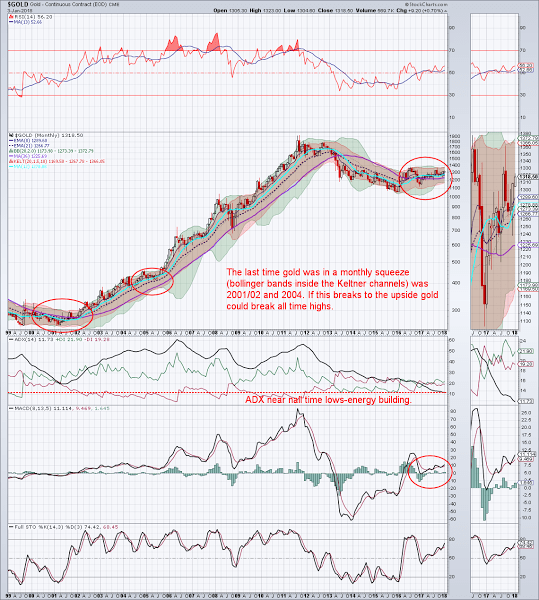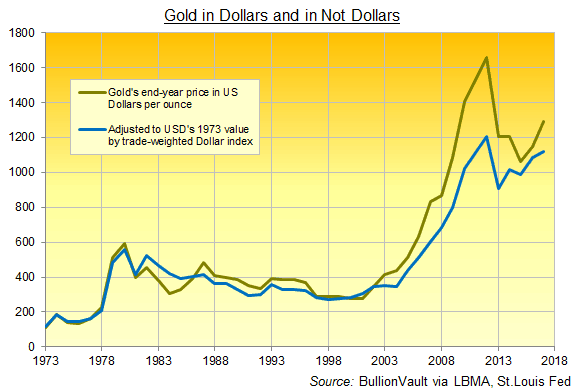2017 was a pretty good year for gold. Although the sentiment towards it has hardly been worse. In the west it seems there is little demand for physical gold and silver.
In our predictions for 2018 we reckon this year could actually be a better year for precious metals than 2017. With the chance that silver may actually rise too and even outperform gold this year.
We didn’t give too many reasons for our 2018 precious metals punts. But we’ve been keeping an eye on other peoples reasons as to why gold and silver will rise in 2018.
While there has been some similarities, we’ve taken note of a variety of very different reasons put forward. Here’s a summary of many of those themes…
Reasons precious metals will rise in 2018 from Sprott Money:
2018 will be defined by three general risks. How these play out will dramatically impact the dollar, the bond market and precious metals. The three risks are:
1. Political Risk —
By late summer of this year, attention will turn to the coming mid-term elections in the US. If the Democrats are poised to regain control of Congress, speculation regarding a move to impeach President Trump will rapidly intensify. How will this affect US fiscal and monetary policy?
2. Geo-Political Risk —
If you’re paying any attention at all to global events, this needs no further explanation. Whether it’s the possibility of renewed war on the Korean Peninsula, conflagration in the Middle East or actual Hot War between NATO and Russia, geo-politics have the potential to greatly unsettle global markets in 2018.
3. De-Dollarization Risk —
The global pace of de-dollarization is clearly quickening. Later this month, a yuan-denominated crude oil contract will begin trading in Shanghai. Later this year, a ruble-denominated gold contract will begin trading in Moscow. These and other events will provide a clear challenge to US dollar hegemony in 2018.
From GoldSilver.com: 3 Facts Show Gold is Set to Surge in 2018
4. Gold Should’ve Fallen in 2017—Instead It Built a Base
Gold went up in 2017 despite all these factors that should have been negative for gold:
• Soaring stocks markets, with all major US markets making numerous new highs throughout the year.
• Raging bitcoin and crypto prices, captivating investors worldwide and dominating headlines, with numerous stories of investors getting rich.
• Rising real estate values, with some areas reporting frothy prices.
• Rising US interest rates, with promises of more from the Fed.
• Higher GDP in the US and many other economies around the world.
• Falling unemployment in the US.
• Higher wages, with the passage of a tax bill that spurred many companies to offer bonuses and wage increases.
• And last, falling gold bullion sales, so soft they reached a 10-year low.
5. The Everything Bubble Is Coming to an End
[S]tocks, bonds, and real estate—the primary investment assets of most North Americans—are all in bubbles.Remember, no trend lasts forever. Since gold is inversely correlated to most major asset classes, it is more likely to rise when stock markets crash.
6. The Technical Picture Shows Gold Coiling for a Big Breakout
The gold price continues to squeeze tighter and tighter on a monthly basis, a technical sign that implies a breakout is coming. The ADX (Average Directional Index) measures the strength or weakness of a trend, and you can see that gold isn’t trending but instead is building energy.
The longer this consolidation goes on, and the greater the buildup in energy, the bigger the breakout will be. In fact, … “long-term consolidations are the most powerful when they finally break out.”
The technical picture doesn’t tell us when this breakout will occur, but as he says a new all-time high could be in the cards if it breaks to the upside. You’ll notice other technical indicators give bullish indications, too.
The point here is that we’re inching closer and closer to a major move in the gold market. And you’ll want to be positioned beforehand to take full advantage. That’s what we’re doing—continuing to buy physical metal now in preparation of a major shift in the markets.
From Adrian Ash: 2018: Dollar Down, Gold Up
7. 2018: Dollar Down, Gold Up – But what about those Not Dollar gold investing…?
A falling dollar should prove generally positive for dollar-denominated commodities, especially gold as a currency in its own right.
The weak dollar outlook stems from other forecasts and guesses: a weaker-than-expected bump from Trump’s tax cuts, to disappointment with the Fed’s pace of rate hikes, plus tighter interest-rate policy in the EU.
But if a drop in the dollar helps push gold higher, doesn’t that mean non-dollar gold investors could miss out? History says maybe. But it’s unlikely.
The dollar’s strength has been reflected in the dollar gold price. When the Dollar Index has fallen 10% or more, gold has risen for US investors. When the Dollar Index has risen by 10% or more, gold has tended to sink in dollar terms. Overall, the Index has tended to reflect moves in dollar gold prices on an annual basis. They have moved in opposite directions some 63% of the time.
However, gold not priced in dollars went in the same direction as gold priced in dollars far more often, moving higher or lower together over 86% of the time. For investors, the 6 years when gold diverged from its dollar price show no clear pattern.
So, movements in the dollar have only tempered or extended the size of gold’s changes for ‘Not Dollar’ investors. They have rarely negated its direction.
A weak or strong dollar has tended to see gold rise or fall for US and non-US investors alike. And for 2018, expert consensus says the dollar is likely to drop.
GSG Editors note: So even if the US Dollar was to strengthen against the Kiwi Dollar (something we don’t expect for 2018). History shows that the “non-dollar” gold investors – such as us in New Zealand – should see gold rise even if the US dollar were to strengthen.
From The World Gold Council: Four key market trends for gold in 2018
The World Gold Council explores four key market trends and their implications for gold:
8. Synchronised global economic growth
Our research shows that continued economic growth underpins gold demand. As incomes rise, demand for gold jewellery and gold-containing technology, such as smartphones and tablets, rises. Income growth also spurs savings, helping increase demand for gold bars and coins.
…Increased consumer demand supports the investment case for gold and highlights its dual nature. Investors often focus on gold’s effectiveness as a hedge against financial shocks. But rising wealth underpins gold consumer demand, which, in turn, supports gold prices over the longrun. The interaction between investment and consumption also results in gold’s lower correlation to other mainstream financial assets, making it an effective diversifier.
9. Shrinking central bank balance sheets and rising rates
Continued global economic expansion will likely result in tighter monetary policy.
…The Fed is also expected to raise rates further.
…But while higher rates increase the opportunity cost of investing in gold, we believe the implications for gold are more nuanced.
The actions that central banks took over the past decade have had substantial implications for the performance of financial markets. As they pumped trillions of dollars, pounds, euros and yen into the global economy and slashed interest rates to – and in some cases below – zero, asset values hit record highs, market volatility reached record lows and prices became increasingly correlated.
It is reasonable to presume that as central banks rein in their expansionary policies, these trends will reverse.
…Gold can help investors manage financial market risks. Our analysis of gold’s performance
during different US real-rate environments reveals that when real rates are between 0% and 4% gold’s returns are positive, and its volatility and correlation with other mainstream financial assets are below long-run averages.
10. Frothy asset prices
Asset prices hit multi-year highs around the world in 2017. In the US, the S&P 500 is at an all-time high and its cyclically adjusted price earnings ratio (CAPE) is at its highest level since the peak of the dot-com bubble in 2000.
In addition, investors have been forced to take on additional risk to generate additional returns.
…Should global financial markets correct, investors could benefit from having an exposure to gold as it has historically reduced losses during periods of financial distress.
11. Market transparency, efficiency, and access.
The London over-the-counter market – historically opaque – witnessed two key developments in 2017. The London Bullion Market Association launched a trade-data reporting initiative, which could bear fruit in 2018. And the London Metal Exchange launched LMEprecious, a suite of exchange-traded contracts intended to improve price transparency and efficiency of transacting in the London wholesale market. [GSG Editor’s note: We’re not convinced about this one yet]
Plans are afoot to develop an exchange in India too.
…Currently, Russia’s tax rules virtually prohibit gold investment. Individual and institutional
purchases of gold bars are subject to value added tax (VAT) of 18% – the highest rate in the world. This may change in 2018. A draft amendment to the tax code proposing an exemption for gold has been submitted for consideration by the Russian government. If approved, it may herald the development of a new gold investment market.And gold-backed investment vehicles around the world are making it easier and cheaper to access gold.
(For timeless reasons on why to buy gold see: Why Buy Gold? Here’s 14 Reasons to Buy Gold Now)
From Samson Li – Precious Metals Analyst at Thomson Reuters GFMS
12. Silver also has an excellent technical set-up
Precious metals analyst Samson Li writing in Thomson Reuters on January 2, 2018 offers this insight in the current technical trading position for silver.
Technically, silver is ripe for a major breakout to the upside in 2018. The CFTC figures Managed Money positions show that COMEX silver has been in a net short for three straight weeks since 12th December. This is not unheard of but is relatively rare for silver; the last time COMEX silver was net short was between the end of June and the first week of August 2015. As investment sentiment can swing from one extreme to another, and given silver’s innate volatility, this net short position should point to the possibility of a sharp short-covering rally. Looking back at the corresponding period in 2015, silver price was trading at $15.61/oz on the 7th July, and it was the third consecutive week recording a net short position. Approximately a year later, silver was trading over $20/oz in July 2016… [T]he current poor sentiment does suggest that silver could be one of the better performing precious metals in 2018, barring any crisis that could trump most of the commodities but gold.
(For more on the reasons to buy silver see: Why Buy Silver? Here’s 21 Reasons to Buy Silver Now)
There you go. 12 quite different reasons why gold and silver might rise in 2018. Let us know in the comments if you can think of any others.
Related: For everything you need to know in determining when to buy gold or silver see: When to Buy Gold or Silver: The Ultimate Guide



